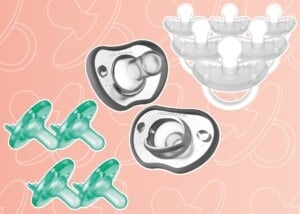When it comes to breastfeeding, there can be so many questions mothers have. One of the most common is how you know your milk is transferring from your breast to baby’s belly during breastfeeding. While your confidence in breastfeeding will undoubtedly increase over time, you may find yourself questioning everything during those first few days and weeks. But don’t worry. This is normal! As a lactation consultant and mama, I know how hard it can be. I promise you’re not alone.
How Do I Know My Baby Is Getting Enough Milk?
This is the most common question I receive as a lactation consultant. For some women, this question can cause fear, anxiety, and concern. For others, this could just be a passing thought. Milk transfer may be the most critical aspect of breastfeeding. It not only helps your baby grow, stay nourished, and be well-hydrated, but it will also help you regulate your breast milk supply.1,2
The amount of breast milk you make is based on a supply and demand type system, which means the more milk you remove from the breast, the more milk you make.3 Conversely, the less milk you remove from the breast, the less milk you make. If your baby can’t transfer milk or has poor milk transfer, your body will assume it doesn’t need to make the milk. So, your milk production will start to slow and possibly stop.2 There are various reasons why your baby may have a decreased or minimal milk transfer. It’s best to navigate these complications with a board-certified lactation consultant.
How To Make Sure Your Milk Is Transferring During Breastfeeding
If you’re concerned about how much milk your baby is getting, I highly recommend working with an International Board-Certified Lactation Consultant (IBCLC). However, there are some telltale signs that your baby is transferring milk from the breast. They’re pretty easy to detect if you’re looking out for them:
1. You Hear Swallows
Once your transitional breast milk has come in (typically around days two through five), you will hear your baby swallowing milk at the breast.4,5 This sounds like a light “caw” sound. I recommend listening out for it, especially in those first couple of weeks of breastfeeding.
2. Baby Is Sucking
When your baby comes to the breast, they will be rapidly sucking until your breasts release milk. Then, the sucks will become more rhythmic and may slow down a bit with rhythmic sucking and swallowing.2
3. Baby Seems Satisfied
Once your baby has fed on both breasts, you will typically notice that they become very content, are relaxed, and appear satisfied. This is a great way to tell if your baby has transferred enough milk to get them through the next feeding.2
4. Your Breasts Feel Softer After Feeding
When your baby can transfer milk from breast to belly, you will find that before feeding, your breasts may feel full or tight and then feel softer to the touch after your baby has fed.7
5. Baby Has Wet and Dirty Diapers
If your baby is taking in enough breast milk, you will find that they’re constantly wet and/or soiling their diaper. Most breastfed babies will have six or more wet and dirty diapers daily.1,2 Yes, daily! This could mean you have a dirty diaper with every feeding, which is amazing! If your baby doesn’t have wet/dirty diapers, please get in touch with your pediatrician and IBCLC.
6. Baby Is Gaining Weight
Is there any better feeling than going to the pediatrician’s or lactation consultant’s office, putting your baby on the scale, and seeing that they’ve gained 7 ounces or more in a week? And knowing it was purely your body providing them with such nutrients?! I think not! You will know your baby is getting enough breast milk when they gain adequate weight for their age.2 In the beginning, babies grow very rapidly. By the three-month mark, their growth will continue but slow a bit.6
I want to note that for many breastfeeding mamas, it may not be as easy as checking boxes in steps one through six. Breastfeeding may take weeks or even months to get to a point where it’s smooth sailing. That’s okay! Make sure to lean on your resources, as they will get you through and help you and baby be successful. As mentioned above, reach out to your pediatrician and lactation consultant if you believe your baby isn’t gaining weight, isn’t taking enough at the breast, doesn’t have enough wet and dirty diapers, or appears dehydrated.











